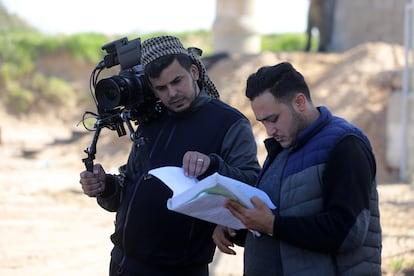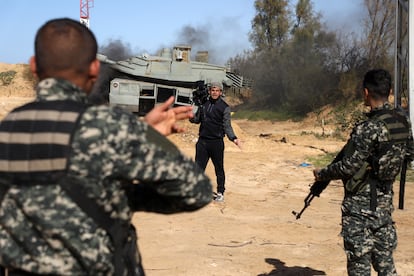Clue or coincidence? The Hamas series about a major surprise attack on Israel
The mastermind behind the October 7 attacks presented ‘Fist of the Free’ a year before the offensive. The similarities between the show and what later happened have sparked debate about whether it was sending a message

The leaders of Hamas’ armed wing decide to launch a major attack that, in the words of one of the men, “will surprise the enemy [Israel] and change the rules of the game.” Only a handful of people know the details, which they have been preparing for some time: it consists of knocking out the control towers at the border barrier, placing bombs under armored vehicles to capture hostages and taking over a military base.
No, this is not reality, nor is it about the days before the attack that the Islamist militia launched on October 7, 2023, when Hamas killed 1,200 Israelis, kidnapped 251 hostages and sparked a bloody Israeli invasion (40,000 Palestinians dead) that has led to the worst unrest the Middle East has seen in half a century. It is Fist of the Free (“Qabdat al-Ahrar” in Arabic), a fictional series filmed a year earlier in Gaza. The show was made by the Hamas government in response to Fauda, the successful Israeli series on Netflix about a group of Mista’arvim, the elite Israeli unit that trains to blend in with the Palestinians. Indeed, coincidentally in the Hamas series, the Mista’arvim have a bald leader and a woman, just in Fauda.
Fist of the Free — which is named after the macro-operation that Hamas is preparing in the show — was broadcast in 2022, during the holy month of Ramadan (when Muslims around the world avidly watch TV series). It was broadcast first on Al-Aqsa, the satellite television of the Islamist movement; and then on Al Manar, which is run by Lebanese party-militia Hezbollah. Its 30 episodes, running for around 50 minutes, went almost unnoticed.
If the show has been resurrected today, it’s not because of its — debatable — quality, but because of the possible clues it offers about the October 7 attacks, which are seen now in retrospect. Tanks burning on the border, fighting between soldiers and militiamen — some scenes of Fist of the Free seem to be taken directly from the real attack.
In the show, when the offensive begins, an Israeli commander puts his hands on his head: “The country is experiencing a serious and very unusual event that we cannot explain. The headquarters in the south is in the line of fire. What is happening is totally abnormal. We have no satellites, no planes, no drones.” It is estimated that, at the time of filming, Hamas was already secretly preparing for Operation-Al Aqsa Flood.

But the clues are not so much in the show itself (looking for prophetic signs in the past is always fraught with problems), but rather as in the statements made about it, which today seem to take on a different meaning. These statements were made by none other than Yahya Sinwar, the mastermind behind Operation Al-Aqsa’s Storm and Israel’s number one enemy, who was appointed the political leader of Hamas after the assassination of Ismail Haniyeh in Tehran.
“I commend the efforts of everyone who created and worked on this series. Your work brings us closer to liberation. This series is an integral part of what we’re preparing in the Iz al-Din al-Qassam Brigades,” he said, referring to Hamas’ military wing. “From the weapons being produced in their laboratories, to their plans and intelligence-gathering abilities for our liberation and return,” he added, before personally presenting the awards to the team. At that time, the Israeli intelligence services condescendingly disdained the signs and warnings.
The series is inspired by a true story: a failed Israeli undercover operation in Khan Yunis, southern Gaza, in 2018. In reality, the Israeli agents were discovered by local residents, who suspected the strangers. It ended in a confrontation in which the Israelis rescued 16 men, killed seven Palestinians and lost only one agent.
In the Hamas production — which can still be found online — the story has been changed. It is the target himself, Abu Anas, who realizes that he is being pursued and goes out to fight. In Fauda, he would be the bad guy; but in Fist of the Free, he is a loving, friendly and smiling family man who sacrifices his life “for the liberation of Palestine.” He fights courageously, but is shot in the neck with a sedative dart. Hamas then launches the operation, with volleys of rockets, just as it really did at dawn on October 7, as a decoy for the mass infiltration.
“Changing the rules of the game”
“We have managed to break the myth that the enemy army is invincible […]. The Fist of the Free must be our plan to surprise the enemy and change the rules of the game. Everyone will know the Fist of the Free,” says one of the leaders in the series, after scolding the militiamen in a training session for going out to capture soldiers in a tank without first knocking down the control towers. Something that Hamas did do on October 7.
Unlike in Fauda, the Israeli agents in the Hamas series are rather clumsy. While in real life, Palestinian detainees are stripped, handcuffed and made to lie down for hours with their eyes covered and kneeling on the ground, in The Fist of the Free, an elite unit goes hours without realizing that Abu Anas is carrying a knife hidden in his sock.

Some shots are filmed with GoPro cameras, at body height, so the footage looks even more like the videos filmed in real life by Hamas militiamen, which have been circulating online. The show has a lot of dramatic music and slow motion, in the same style of the series that are popular in the Arab world.
Hamas set up an arts production department after taking control of Gaza in 2007. Its head, Mohammed Soraya, admitted to Al Jazeera in 2022 that Fist of the Free was intended to “show the Palestinian viewpoint, the Palestinian resistance and the fighting spirit that resists the occupation,” and to counter Fauda’s “deception” and “great influence” on public awareness. “Netflix is supporting the Zionist occupation by producing many series like Fauda that depict the Palestinian people as criminals,” he added.
The series has all the limitations of a production shot in a Gaza under Israel’s blockade. There are no studios in Gaza, so they filmed for half a year only outdoors and during the day. They did not have the equipment for night shots. On one occasion, Israeli soldiers opened fire on the set, thinking it was real. Some of the shots were filmed with the cameraman standing on the shoulders of another. The budget: $90,000.
Many of the actors were amateurs, and there were obviously no Israelis to play the roles of the Israeli leaders, unlike in Fauda, where the Palestinian characters speak Arabic and the Israelis speak Hebrew (or Arabic, when they are on a special operation or joking around). It’s like those Hollywood movies where everyone speaks English to each other abroad. Zohair Al-Belbisi, the 65-year-old actor who plays a Shin Bet officer, looks more Egyptian than Israeli, but he met with former prisoners to prepare for the role.
Whether prophetic or not, the series is a window into the Palestinian Islamist universe. The family is at the center, offering crucial support for the militants. Women must watch their movements so as not to give the enemy any clues about their whereabouts. One character flatters his son by calling him Izz ad-Din al-Qassam, the influential preacher who fought to expel the British, French and Zionists from the Middle East, who inspired the name of Hamas’ military wing.
Some of the dialogues are more like morale-boosting pleas to the viewer: “Of course, the enemy has a sophisticated arsenal, but we have an unbreakable will. Yes, they are powerful, they fight, but they are afraid to die. We are not; and we believe that God will give us victory.”
Sign up for our weekly newsletter to get more English-language news coverage from EL PAÍS USA Edition
Tu suscripción se está usando en otro dispositivo
¿Quieres añadir otro usuario a tu suscripción?
Si continúas leyendo en este dispositivo, no se podrá leer en el otro.
FlechaTu suscripción se está usando en otro dispositivo y solo puedes acceder a EL PAÍS desde un dispositivo a la vez.
Si quieres compartir tu cuenta, cambia tu suscripción a la modalidad Premium, así podrás añadir otro usuario. Cada uno accederá con su propia cuenta de email, lo que os permitirá personalizar vuestra experiencia en EL PAÍS.
¿Tienes una suscripción de empresa? Accede aquí para contratar más cuentas.
En el caso de no saber quién está usando tu cuenta, te recomendamos cambiar tu contraseña aquí.
Si decides continuar compartiendo tu cuenta, este mensaje se mostrará en tu dispositivo y en el de la otra persona que está usando tu cuenta de forma indefinida, afectando a tu experiencia de lectura. Puedes consultar aquí los términos y condiciones de la suscripción digital.
More information
Archived In
Últimas noticias
A survivor’s account of the Interoceanic Train accident: ‘We were scared because of the speed on the curve’
The Interoceanic Train, the Mexican alternative to the Panama Canal
What is known about the Interoceanic Train derailment in Oaxaca
Trump turns a Minnesota fraud allegation into ammunition for his MAGA army against Democrats
Most viewed
- Oona Chaplin: ‘I told James Cameron that I was living in a treehouse and starting a permaculture project with a friend’
- Reinhard Genzel, Nobel laureate in physics: ‘One-minute videos will never give you the truth’
- Why the price of coffee has skyrocketed: from Brazilian plantations to specialty coffee houses
- Pablo Escobar’s hippos: A serious environmental problem, 40 years on
- Chevy Chase, the beloved comedian who was a monster off camera: ‘Not everyone hated him, just the people who’ve worked with him’











































